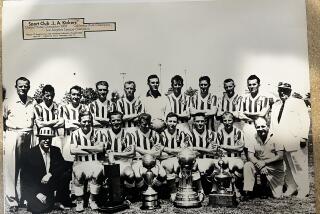Ruling Raises Cup for San Diegans : Yacht Official Says It’s What They Expected All Along
SAN DIEGO — The club room of the San Diego Yacht Club was filled with lights, cameras, minicams--and people. A sign on the wall read “Capacity 120 Persons,” but many more were cramped inside.
A banner on the wall bore a picture of the America’s Cup with this inscription:
“Welcome Home, Baby! Our Cup runneth over with joy! Sept. 19, 1989.”
A huge angel food cake at the front of the room was decorated with thick chocolate frosting that read:
“Thumbs Up, Cup!”
Francis S. Radford, vice commodore of the yacht club, called the symbol appropriate, saying that Tuesday’s 4-1 decision by the appellate division of the New York Supreme Court--overturning the New Zealand challenge and giving the Cup back to San Diego--was “like frosting on the cake . . . the outcome is what we expected all along.”
Gone was any talk that the matter might not be over yet. Michael Fay, head of the New Zealand Challenge, could still petition the court by Oct. 19 to have the case heard at a higher level. One point in San Diego’s favor is that the higher court may elect not to hear the case, in effect upholding Tuesday’s ruling.
If that is the case, then the Cup will be contested in full grandeur here starting in the fall, 1991, almost four years after Dennis Conner, sailing Stars & Stripes ‘87, won the Cup for the San Diego Yacht Club at Fremantle, Australia.
So, in the meantime, San Diego celebrated the decision. Local officials estimated the Cup could mean a $1-billion windfall for city coffers. Sailing syndicates from a legion of foreign countries could begin arriving in the city as early as the fall of 1991, with championship races being held in May, 1992.
Radford and Thomas F. Ehman Jr., the executive vice president and general manager of the America’s Cup organizing committee, told reporters and yacht club members that they expected the Cup to remain in San Diego and that preparations for the ’92 defense would begin, in Ehman’s words, “immediately.”
Radford said the San Diego Yacht Club had spent “more than $1 million” on legal fees in the past year, although he declined to give an exact amount.
While conceding the legal battle as “acrimonious” and “unfortunate,” he said the “perverse side effect” was that awareness of and interest in the America’s Cup had never been greater. He said that San Diego, more than any host city before it, would be the direct beneficiary of an “unintended but very effective marketing campaign.”
Tom Mitchell, a spokesman for the America’s Cup organizing committee, agreed:
“The long-term impact (of the legal battle) is that it’s made the event more popular than ever. People who never heard of the America’s Cup have heard of it now. There was a Gallup Poll last year that pointed out that 79% of the American public had heard of the Cup. That’s incredible.
“As recently as 1983, we were dealing with an event that wasn’t all that popular in terms of international recognition. So, in the long run, it’s great for us. We win in several ways.
“We win not only in the sense that controversy sells newspapers, but now there’s an incredible sense of cooperation between challengers and defenders. No one wants this kind of bitter acrimony to surface ever again. Everyone has agreed to a new class of boat, and now we’re ready to get on with the race.”
San Diego community leaders were obviously optimistic. Vince Benstead, president of the Greater San Diego Sports Assn., said by hosting the 28th America’s Cup San Diego’s status as a sports city would rise. He alluded to such other events as Super Bowl XXII and the America’s Cup Challenge in 1988, San Diego’s being named the site of the 1992 baseball All-Star game (the 1978 game was played here), and “Now this,” he said. “I can’t think of a more deserving place.”
Benstead said that committees would soon be formed to “organize the event in every way, shape and form.” He said that “every last detail” would include planning on the part of the city, the San Diego Police Department, the Coast Guard, the Navy, the Board of Port Commissioners, the San Diego Chamber of Commerce and the San Diego Convention & Visitors Bureau.
Radford said that May of ’92 was picked because February to May “offers the best four-month window in San Diego from everything to wind and weather to hotel space. We’re looking at a terrific event.”
AMERICA’S CUP RULING
The New York Supreme Court returns the America’s Cup to San Diego. Rich Roberts’ story, Part I, Page 1.
CUP CONTROVERSY CHRONOLOGY
Feb. 4, 1987--Dennis Conner, sailing Stars & Stripes ’87 12-meter, wins America’s Cup for San Diego Yacht Club by defeating Kookaburra III in four consecutive races at Fremantle, Australia.
July 17, 1987--Michael Fay, head of a New Zealand syndicate, challenges San Diego YC on behalf of Mercury Bay Boating Club and declares he will sail a boat measuring 90 feet at the waterline--the largest permitted by the rules. His challenge ignored, Fay goes to court.
Nov. 25, 1987--New York State Supreme Court Justice Carmen Ciparick rules that San Diego YC must defend against Mercury Bay.
Sept. 7 and 9, 1988--Conner, sailing a 60-foot catamaran, defeats New Zealand’s 130-foot monohull in two consecutive lopsided races. Fay returns to court.
March 28, 1989--Ciparick rules catamaran illegal, awards Cup to Mercury Bay.
Sept. 19, 1989--Appellate Division of New York State Supreme Court reverses Ciparick in 4-1 opinion, restoring Cup to San Diego.
More to Read
Sign up for The Wild
We’ll help you find the best places to hike, bike and run, as well as the perfect silent spots for meditation and yoga.
You may occasionally receive promotional content from the Los Angeles Times.






